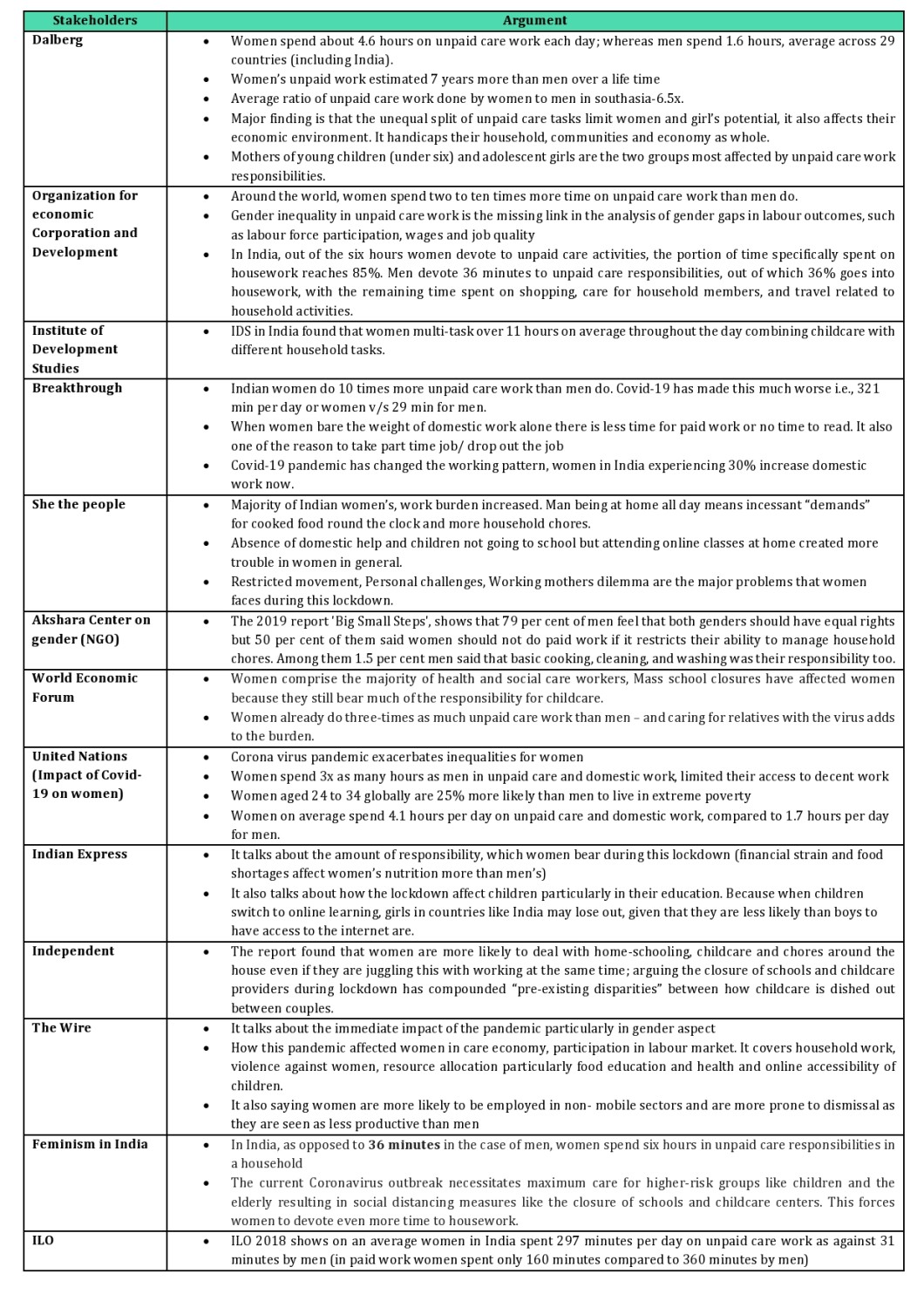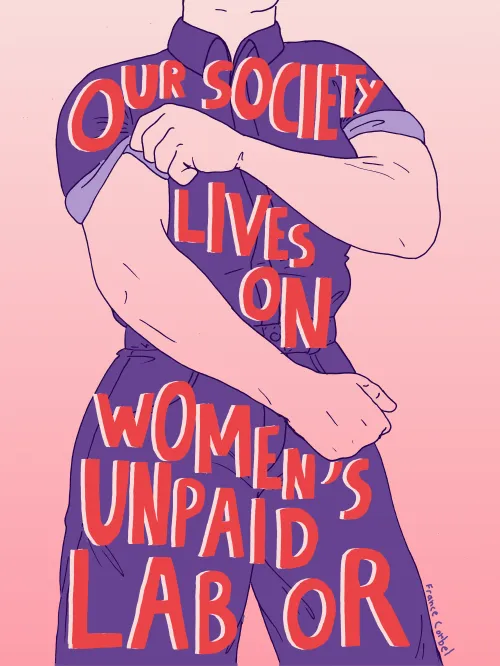The Nil Journal
Gendered impact of the Lockdown

Gendered impact of the Lockdown
An online research series by Nil
Nil Team
Women’s paid and unpaid work, and their economic participation, is a well-established global
priority for gender equality, as reflected in the 2030 Agenda for Sustainable Development.
SDG Target 5.4 focuses specifically on recognizing and valuing unpaid care work, and SDG Target 5.5
on women’s full participation in economic life.
Promoting gender equality in care-giving at home, would mean to both recognize and redistribute
unpaid care work, which all too often falls to women and girls. Redistribution is essential both to
relieve the unequal burden placed on women and girls and to facilitate women’s access to paid work
by removing time and service-related barriers and constraints.
While there have been numerous attempts to explain the gendered patterns of time spent on housework
and childcare and, although there is support for each of them, none can fully account for the
gendered patterns of unpaid work time. There is an opportunity therefore, to recognize and reduce
unpaid care work to facilitate women’s engagement in the labour market and to promote women’s
empowerment across generations.
Amartya Sen’s Capability Approach (CA) talks about “development as seen as a process of expanding
the real freedoms that people enjoy.” Rather than goods and resources, this approach focuses on
people and their capabilities, which includes people’s choice, ability, and opportunity to transform
resources to achieve functioning. Gender is one of the major alternate perspectives of Sen’s
approach. Mainly it describes the equality of outcomes from the perspective of equality of
opportunities. It also emphasizes social relationships and institutions as determinants of the
“capability spaces” that allow for equal freedoms for different groups of women and men. It also
highlights the difficulty of unpacking what “freedom of choice” means in different contexts.
The way to address time poverty is different for men and women. Women carry out at least two and
half times more unpaid household and care work than men. Work in the informal sector, care work
and household maintenance all are examples of work that is ignored, even not acknowledged in GDP.
Does that mean this work is unimportant? In this scenario, it is important therefore to give
visibility to unpaid work in formal statistics, to understand the linkages between paid and unpaid
work, the disproportionate amount of time women dedicate to unpaid labour.
But it is only when we take risks, when we experiment, are we truly alive. Along the path of
experimentation, we will always find ourselves under the scrutiny of nay-sayers, telling us that we
need to stop and change directions. But as experiment architects, we know that the act of immersing
ourselves into trying something new and it not working, is far more satisfying than not trying at
all. The world needs experiment architects like Nil, even more today, because of the tough times we
live in, increasingly becoming complex and full of conflicts. As design-doers, we must take the risk
to enter into the unknown areas because only with experimentation can we design solutions that are
path-breaking, resilient, and cognizant of the multiple contexts we live in today.
Why is such a discourse pertinent, especially in the context of COVID-19?
The Covid-19 lockdown has resulted in a rapid shift in household functioning and its environment.
The roles of both women and men within the household have subsequently undergone significant changes
during this period. Even on “normal” days, women face a disproportionate burden of household chores,
care responsibility for higher risk groups (children, elderly, disabled, sick, etc.), while
participating in the labour market. The current crisis has put additional stress and drudgery for
women in dealing with family, work, and mental health related issues during such a time. Women have
to shoulder the lion’s share of unpaid work such as home schooling, childcare, and household chores
while working (what is categorized as ‘productive work’) at the same time. This is especially
relevant in developing countries like India, where the socio- cultural norms are deeply entrenched
in many homes, and people still believe that managing a household is a women’s responsibility. In
the context of Covid-19 lockdown, more number of people are at home all the time, more people means
more food to be cooked, more care needs to be provided in all aspects and therefore it is pertinent
to understand who shoulders these responsibilities and the impact it has on those individuals.
Moreover, the economic crisis has created implications for food security, health, and education of
women and girls and particularly in a situation where income shrinks, men may be prioritized for
availing resources than women. Hence, it may put women’s health and access to opportunities and
freedoms at an additional risk.
This epidemic has also changed the work pattern by introducing digital technology as an integral
part of work. It is giving rise to newer challenges for working people from various age categories
and professions. Additionally, children are also now switching to online classes and digital
learning. Such a shift, exposes India and other such developing countries to a deep digital divide.
Many households in these countries do not have a broadband connection at home, and despite many
parents having mobile internet connectivity, still, it may not be sufficient to reach everyone. Such
a situation is bound to affect girls in India disproportionately, owing to the fact that girls are
less likely than boys to have access to internet as well as digital devices.
The impact of a global pandemic on the economy, health and digital use needs to be understood and
subsequently reflected upon so that interventions that are implemented in practice can address the
emerging challenges and utilize the opportunities presented; they need to be reflected in the
planning tools that determine the design of intervention and the process of planning activities that
provide space for the inclusion of needs of different social groups.
In this context, recognizing that the pandemic has created significant shifts in people’s behaviour
and their surroundings, Nil, the design lab at NRMC is conducting a time use survey to explore the
gendered impact of the lockdown within the household across geographies.
This Time-Use Survey has been designed to record the daily activities of members of a household to
uncover how paid and unpaid labour duties, care works, leisure and personal needs, transportation,
are divided up among family members.
Importance of Time use survey

A Time Use Survey (TUS) is a multi-purpose survey, which provides an overview of people’s time use
over a specific period. TUS reflects the daily life details of the individual, which do not appear
in any other type of surveys and studies.
This survey will enable measuring time spent by individuals on paid and unpaid activities such as
formal labour, voluntary work, social and cultural activities, housekeeping and personal work,
leisure time, mobility, etc. It will be an important source of information on the time spent doing
unpaid caregiving activities, unpaid volunteer work and unpaid domestic service-producing activities
of the household members. Moreover, the TUS will provide insights on the amount of time spent on
learning, socializing, leisure activities, self-care activities, etc. by the household members. It
will further help in understanding individual and household behaviour, especially with respect to
time allocation decisions.
Current Discourse on Paid and Unpaid Work in India

While the table above depicts the discourse in the Indian context, there are similar discourses
across other countries as well.
Considering the above mentioned studies and findings, it is relevant to understand how such a crisis
affects people across gender, age, class and caste categories in different ways. The study will
therefore attempt to unveil the existing gendered division of labour and gender norms prevalent in
the society and the impact of Covid-19 on the same. This study will also distinguish equality of
outcomes from equality of opportunities and explore the behavioural patterns between genders.

Offerings of Nil’s Time-Use Survey in the context of Covid- 19
Given the universal impact of a pandemic like Covid-19 as well as the global applicability of the
discourse on paid and unpaid work, Nil’s research attempts to reach international audiences and
cover respondents globally. The primary objective of the TUS is to measure the participation of men/
boys, women/girls and other groups of persons in paid and unpaid activities. This will be an
important source of information on the time spent doing unpaid care activities, which often remains
unrecognized and undervalued. In this regard, Nil’s TUS will offer a detailed portrait of how each
member in a household spends their time, what activities they engage in and its gendered
implications. Such data will powerfully illustrate the unevenly distributed burden of work.
Additionally, Nil’s TUS would also be a powerful source for policy makers and development partners
to develop policies, strategies, and interventions that address the needs of women and men in the
country.
As part of the larger Online Research Series, Nil will be conducting the following researches to
uncover the gendered impact of the lockdown. This will include aspects such as:
- time use pattern for paid and unpaid care work
- nutritional pattern based on daily consumption (because women are at higher risk of malnutrition during health emergencies)
- digital access and ease of using technology (especially owing to intersections of gender and socio economic background worsening the situation for adolescent girls from poor families).
- access to leisure or entertainment to understand the source and time spent for doing such activities including the aspect of ‘choice’ and ‘autonomy’.
Use of Nil’s online research series at a glance
This distribution of paid and unpaid work between men and women determines the hierarchy within the
household. This hierarchical gender relation is one of the most pervasive sources of inequality.
Therefore, one of the objectives of Nil’s Time Use Survey is to determine gender
equalities/inequalities in paid and unpaid work.
This research series can contribute in the following aspects:
- Strengthen the ongoing discourse around the gendered impact of lockdown with real time data.
- Advocacy with relevant government ministries/departments for appropriate interventions or policies
- Knowledge sharing/thought leadership with larger strategic group through webinar and other platforms
